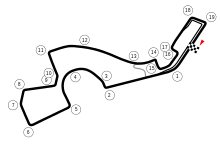메시에 83
Messier 83| 메시에 83 | |
|---|---|
 | |
| 관찰 데이터(J2000 epoch) | |
| 콘스텔레이션 | 히드라 |
| 적경 | 13h 37m 00.919s[1] |
| 적위 | -29°51°56.74°[1] |
| 레드시프트 | 0.001721±0.000013[2] |
| 헬리오 반지름 속도 | 508 km/s[3] |
| 거리 | 14.7 Mly (4.50 Mpc)[3] |
| 겉보기 등급 (V) | 7.6[4] |
| 특성. | |
| 유형 | SAB(s)c[2] |
| 겉보기 크기 (V) | 12′.9 × 11′.5[5] |
| 기타 명칭 | |
| 남풍차 은하, NGC 5236, PGC 48082, UGCA 366[6] | |
메시에 83 또는 M83은 남쪽 바람개비 은하, NGC 5236으로도 알려져 있으며, 약 1500만 광년 떨어진 히드라와 센타우루스자리 경계에 있는 막대나선은하입니다[7].니콜라 루이 드 라카유는 1752년 2월 23일 [8]희망봉에서 M83을 발견했다.샤를 메시에가 1781년 [8]3월 그의 성운 천체 목록에 그것을 추가했다.그것은 하늘에서 가장 가깝고 밝은 막대나선은하 중 하나이며 쌍안경으로 [9]볼 수 있습니다.남쪽[a] 바람개비의 별명은 바람개비 은하(M101)와 닮았기 때문에 붙여졌다.
특성.
M83은 거대하고 웅장한 디자인의 소용돌이 [10]은하입니다.De Vaucouleurs 시스템에서 형태학적 분류는 SAB([2]s)c이며, 여기서 'SAB'는 약한 막대의 나선형, 's'는 고리가 없는 순수한 나선형 구조, 'c'는 나선팔이 느슨하게 [11]감긴 것을 의미한다.특이한 왜소은하 NGC 5253은 M83 [12]근처에 있으며, 두 은하는 지난 10억 년 동안 상호 작용하여 [10]중심부에서 폭발적 항성 폭발 활동을 일으켰을 가능성이 있습니다.
M83의 별 형성 속도는 밀도파 [13]이론에서 예측한 바와 같이 나선팔의 앞쪽 가장자리를 따라 더 높습니다.2008년 4월 16일 NASA의 은하 진화 탐사기 프로젝트는 은하계 바깥쪽에서 중심으로부터 20km 떨어진 곳에서 많은 수의 새로운 별들을 발견했다고 보고했다.지금까지 이 지역은 별 [14][15]형성에 필요한 재료가 부족하다고 여겨져 왔다.
초신성
M83에서는 SN 1923A, SN 1945B, SN 1950B, SN 1957D,[16] SN 1968L 및 SN 1983N의 6개의 초신성이 관측되었다.
환경
M83은 가까운 [17]은하군인 센타우루스 A/M83 그룹 내 두 개의 하위 그룹 중 한 개의 중심에 있습니다.센타우루스 A는 다른 부분군의 중심에 있습니다.이들은 1개의 [18][19]그룹으로 식별되기도 하고 [20]2개의 그룹으로 식별되기도 합니다.그러나 센타우루스 A 주변의 은하와 M83 주변의 은하는 물리적으로 서로 가깝고 두 부분군은 [21]서로 상대적으로 움직이지 않는 것으로 보입니다.
「 」를 참조해 주세요.
- 메시에 오브젝트 목록
- M83(밴드)은하의 이름을 딴 밴드
레퍼런스
- ^ a b Skrutskie, Michael F.; Cutri, Roc M.; Stiening, Rae; Weinberg, Martin D.; Schneider, Stephen E.; Carpenter, John M.; Beichman, Charles A.; Capps, Richard W.; Chester, Thomas; Elias, Jonathan H.; Huchra, John P.; Liebert, James W.; Lonsdale, Carol J.; Monet, David G.; Price, Stephan; Seitzer, Patrick; Jarrett, Thomas H.; Kirkpatrick, J. Davy; Gizis, John E.; Howard, Elizabeth V.; Evans, Tracey E.; Fowler, John W.; Fullmer, Linda; Hurt, Robert L.; Light, Robert M.; Kopan, Eugene L.; Marsh, Kenneth A.; McCallon, Howard L.; Tam, Robert; Van Dyk, Schuyler D.; Wheelock, Sherry L. (1 February 2006). "The Two Micron All Sky Survey (2MASS)". The Astronomical Journal. 131 (2): 1163–1183. Bibcode:2006AJ....131.1163S. doi:10.1086/498708. ISSN 0004-6256. S2CID 18913331.
- ^ a b c de Vaucouleurs, G.; et al. (1991). "Third reference catalogue of bright galaxies". 9. New York: Springer-Verlag.
{{cite journal}}:Cite 저널 요구 사항journal=(도움말) - ^ a b Tully, R. Brent; et al. (August 2016). "Cosmicflows-3". The Astronomical Journal. 152 (2): 21. arXiv:1605.01765. Bibcode:2016AJ....152...50T. doi:10.3847/0004-6256/152/2/50. S2CID 250737862. 50.
- ^ "Messier 83". SEDS Messier Catalog. Retrieved 30 April 2022.
- ^ "NASA/IPAC Extragalactic Database". Results for NGC 5236. Retrieved 8 December 2006.
- ^ "M 83". SIMBAD. Centre de données astronomiques de Strasbourg. Retrieved 29 November 2009.
- ^ "Multimedia Gallery: M83 – Southern Pinwheel Galaxy". NASA/JPL-Caltech/WISE Team. 25 June 2010.
- ^ a b Jones, K. G. (1991). Messier's Nebulae and Star Clusters (2nd ed.). Cambridge: Cambridge University Press. ISBN 978-0-521-37079-0.
- ^ "M 83". messierobjects101.com. 11 October 2016. Retrieved 19 April 2018.
- ^ a b Calzetti, Daniela; Conselice, Christopher J.; Gallagher, John S., III; Kinney, Anne L. (August 1999). "The Structure and Morphology of the Ionized Gas in Starburst Galaxies: NGC 5253/5236". The Astronomical Journal. 118 (2): 797–816. arXiv:astro-ph/9904428. Bibcode:1999AJ....118..797C. doi:10.1086/300972. S2CID 16296827.
- ^ de Vaucouleurs, Gérard (April 1963). "Revised Classification of 1500 Bright Galaxies". Astrophysical Journal Supplement. 8: 31. Bibcode:1963ApJS....8...31D. doi:10.1086/190084.
- ^ Thim, Frank; et al. (June 2003), "The Cepheid Distance to NGC 5236 (M83) with the ESO Very Large Telescope", The Astrophysical Journal, 590 (1): 256–270, arXiv:astro-ph/0303101, Bibcode:2003ApJ...590..256T, doi:10.1086/374888, S2CID 121984029
- ^ Silva-Villa, E.; Larsen, S. S. (January 2012). "The relation between surface star formation rate density and spiral arms in NGC 5236 (M 83)". Astronomy & Astrophysics. 537: 9. arXiv:1111.1249. Bibcode:2012A&A...537A.145S. doi:10.1051/0004-6361/201117432. S2CID 119295019. A145.
- ^ "Stellar Birth in the Galactic Wilderness". 16 April 2008. Retrieved 15 December 2018.
- ^ Dong, Hui; et al. (July 2008). "Spitzer Observations of Star Formation in the Extreme Outer Disk of M83 (NGC5236)". The Astronomical Journal. 136 (1): 479–497. arXiv:0804.3632. Bibcode:2008AJ....136..479D. doi:10.1088/0004-6256/136/1/479. S2CID 119189782.
- ^ Romaniello, Martino; Patat, Ferdinando; Panagia, Nino; Sparks, William B.; Gilmozzi, Roberto; Spyromilio, Jason (August 2005), "Very Large Telescope FORS1 Imaging Polarimetry of M83 (NGC 5236). I. Search for Light Echoes from Historical Supernovae", The Astrophysical Journal, 629 (1): 250–258, arXiv:astro-ph/0505100, Bibcode:2005ApJ...629..250R, doi:10.1086/431470, S2CID 118978264
- ^ Karachentsev, I. D.; et al. (2002). "New distances to galaxies in the Centaurus A group". Astronomy and Astrophysics. 385 (1): 21–31. Bibcode:2002A&A...385...21K. doi:10.1051/0004-6361:20020042.
- ^ R. B. Tully (1988). Nearby Galaxies Catalog. Cambridge: Cambridge University Press. ISBN 978-0-521-35299-4.
- ^ Fouque, P.; Gourgoulhon, E.; Chamaraux, P.; Paturel, G. (1992). "Groups of galaxies within 80 Mpc. II – The catalogue of groups and group members". Astronomy and Astrophysics Supplement. 93: 211–233. Bibcode:1992A&AS...93..211F.
- ^ Garcia, A. (1993). "General study of group membership. II – Determination of nearby groups". Astronomy and Astrophysics Supplement. 100: 47–90. Bibcode:1993A&AS..100...47G.
- ^ Karachentsev, I. D. (2005). "The Local Group and Other Neighboring Galaxy Groups". Astronomical Journal. 129 (1): 178–188. arXiv:astro-ph/0410065. Bibcode:2005AJ....129..178K. doi:10.1086/426368. S2CID 119385141.
외부 링크
- WikiSky의 Messier 83: DSS2, SDSS, GALEX, IRAS, Hydrogen α, X-Ray, Astrophoto, 스카이 맵, 기사 및 이미지
- ESO Photo Release eso0136, 막대나선은하 메시에 83의 적외선 초상화
- M83, SEDS Messier 페이지
- 요시다 다카유키 우주사진 촬영장 나선형 은하 메시에 83
- M83 남풍차
- 젊은 초신성 잔해에서 발견된 X선(SN 1957D)
- Bauer, Amanda; Haese, Paul. "M83 – Southern Pinwheel Galaxy". Deep Sky Videos. Brady Haran.
- Constellation Guide의 Messier 83(남쪽 바람개비 은하)



